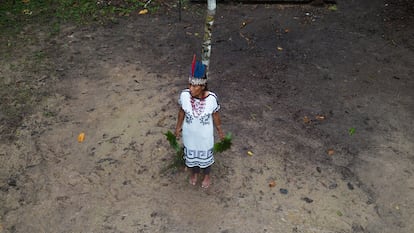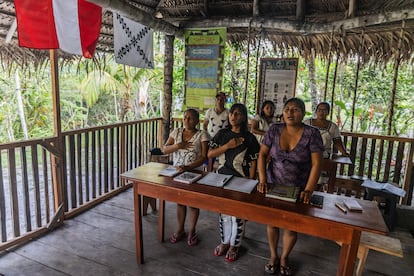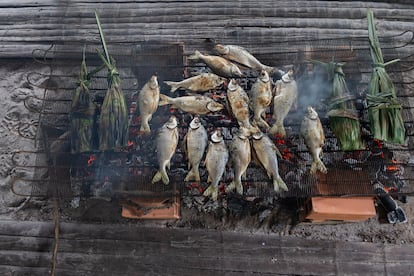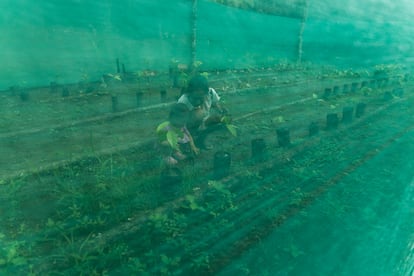EL PAÍS offers the América Futura section for free for its daily and global informative contribution on sustainable development. If you want to support our journalism, subscribe here.
A community song, spread out in a circle, resounds in the middle of the forest and blends in with the chirping of some birds. Several members of the Murui Buue ethnic group dance around the trunk of a tree, at the foot of which Desiré, a six-year-old girl, digs in the earth, as if searching for roots submerged in the depths of mud and memory.
Zoila Ochoa, leader of Centro Arenal, a community located an hour from Iquitos along the Amazon River, is in the circle and has a crown of blue macaw feathers. She raises her arms to the sky and sings in her language, in which her name is Nofikɨ Komekɨ (Heart of stone). Desiré is called Buenaño (Mermaid) and a little girl jumping nearby is Safia (Flower).
Safia is the only person from this community registered in the National Registry of Identification and Civil Status (Reniec) with her indigenous name. All the others, who number more than 40, have a name in Spanish, but also in Murui Buue, a language that is not yet recognized as one of the 48 indigenous languages spoken throughout Peru.
The Ministry of Culture does recognize the Murui Muinani. Although Ochoa maintains that this language is not the same as the one she has been trying to preserve since 2000. She does so at the Murui Buue Centro Arenal Río Amazonas Autonomous School, now located in her home, a cozy wooden cabin where various colorful posters hang representing objects, plants, animals and fruits.
One of them says Oogodomeans banana; another, has the drawing of a condor and says Urujaiño; and in another there is a tree and it says AmenWith this and other teaching methods, the members of this community save their words, their worldview, their way of being in the jungle. And they also save the forest by planting trees and medicinal plants.
The Murui Buue, according to testimonies collected by the anthropologist Carlos Quispearrived in this part of the Amazon at the beginning of the 20th century, when the rubber boom was raging. Julio César Arana, an individual who undertook a genocide to expand his rubber plantations (Hevea brasiliensis), brought them by force from the Putumayo River basin.
On a recent night, in front of a campfire, wise old man Santiago Pérez Flores tells the story of an indigenous girl who came across a baby boa. Later, Zoila recounts that her father arrived “on foot during the war with Colombia,” a jungle border conflict that this country fought with Peru in 1932. She knew that there were already people of her ethnicity here.
All this means that, to this day, the memory of the ‘rubber rush’ is a tormenting one for the Murui Buue. When that cursed era ended, around 1912 and because the British planted syringe In Southeast Asia, they settled permanently in these lands, which owe their name to the sand found between the forest.
Fighting against dispossession
In 1975, during the government of General Juan Velasco Alvarado, Centro Arenal managed to be titled as a native community. But then other problems began: when Peru went from rubber fever to a certain boom oil workers came to the community, as Quispe explains, migrants from other places attracted by the work that hydrocarbons provided.

Sebastian Castaneda
The presence of non-indigenous community members led some of the new inhabitants to file a lawsuit in 2000 for the territory to be parceled out (and eventually sold by its owners), according to them because there were no more indigenous people living there. “It was then that my uncle Arturo Garay stood up at an assembly to protest,” he says.
Garay, the last Murui Buue speaker in this community, promoted the rescue of the dances, the customs, the songs, the language itself. Without his influence, the traditional clothing (white with black geometric figures), the indigenous names used by the community members, and the traditional management of the forest would not exist today.
That same year, the language was taught through songs, dances and stories. In 2004, the dance group ‘Tuhuayo’ was formed, which is the one that performed in the middle of the forest, where Buinaño turned the earth. In 2010, the teaching moved to Zoila’s house, where in addition to the posters, there are folders, a blackboard, a I will slug.

Sebastian Castaneda
Garay died in 2018, but Zoila had already taken the lead in this task. She also created the Asociación Mujer Semilla, one of whose tasks consists of planting plants in an area of 1.7 hectares, of the 1,900 that the community has in total. There they plant forest, medicinal and fruit species, such as the umarí (Poraqueiba sericea), which they call Nekana.
Or the sacha garlic (Mansoa alliacea), a medicinal species that was even used as a palliative during the pandemic. On the edge of a road, there is a cedar sapling (Cedrela odorata), a tree that can take decades to grow. Zoila’s gaze towards the forest seems to point to the future as well, while her grandchildren run around nearby.
Caring for the forest
This is a crucial issue. According to studies by Conservation International (CI), an institution that in 2022 awarded Zoila the scholarship of the Indigenous Women of the Amazon Program to strengthen work in the community, forests, wetlands and mangroves are gigantic carbon deposits, due to their enormous capacity to capture CO2.

If the forests in the Centro Arenal territory are further degraded, a tipping point will occur. ‘unrecoverable carbon’meaning a carbon loss that will take a long time to reverse, and which will make the fight against climate change more difficult. Also in this corner of the Earth where biodiversity is still alive.
A toucan (nokaido in Murui Buue) has just landed on a tree near the kitchen of Ochoa’s house, as if to prove it. Meanwhile, she and her family cook the boquichico fish (Prochilodus nigricans) wrapping them in leaves of a palm tree called panga umbrellawhich she extracted from the forest with axe blows.
To drink there will be cahuana, a traditional drink that is prepared with essence of cassava starch and fruit extract such as aguaje (Mauritia flexuosa), which in the Amazon is known as the tree of life. There is a huge pot in which men and women from the Autonomous School take turns stirring the liquid with a wooden ladle.
The indigenous culture lives here, and the forests survive, but new threats, similar to those that hit the ecosystems and the indigenous people in the past, are looming. The Murui Buue have an Environmental and Territorial Crime Alert System (SAAT) to contain attempts to invade their territories. To do this, they have a drone.

The fight continues
Zoila recalls a recent occasion when a group of settlers tried to enter a section of the community. Her son Arthur Cruz Ochoa, the community leader, whose name is Monilla Amena (Tree of abundance), went with a group of community members to confront the invaders. She was there too and says that “there were shouts and almost a fight.”
Nearby there is a road that aims to go from Iquitos to the Straiton the border with Colombia, crossing part of the community’s territory. “If it is done, only those who want to do business will come in,” he says, as if imagining a future full of shops and not forests. The State will have to consult thembut that has not happened yet.
In the end, this community is resisting and, as a preliminary study by the School of Anthropology of the University of the Peruvian Amazon (UNAP), led by Juan Pablo Moncada, says, it is in a “process of cultural revitalization.” Safia, Buinaño and I’m not a motorcycle (Root of this Earth) who dance with big smiles.
#Murui #Buue #language #lives #songs #resisting #jungle